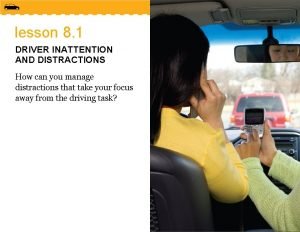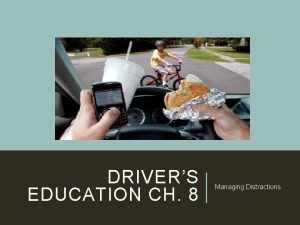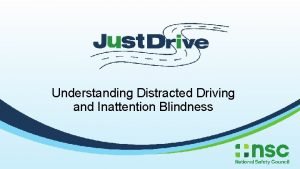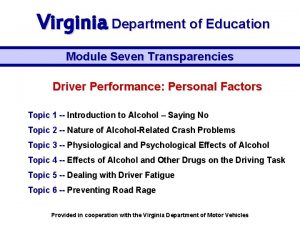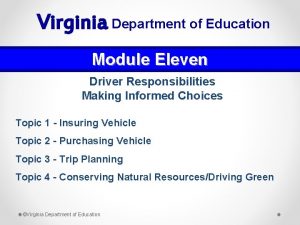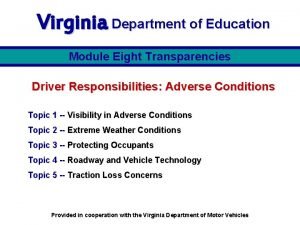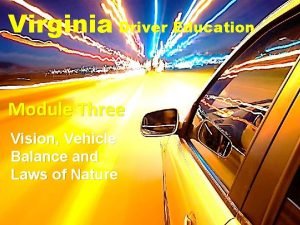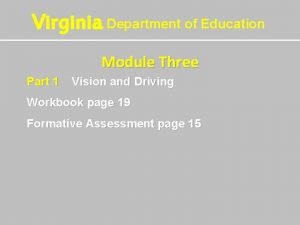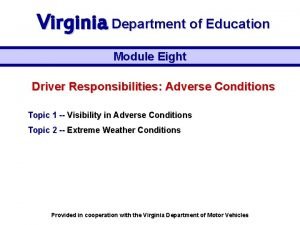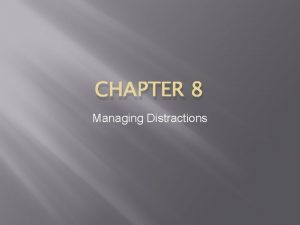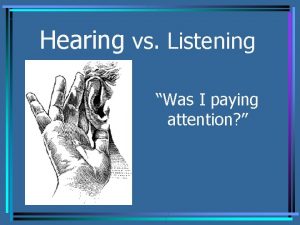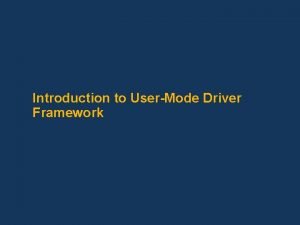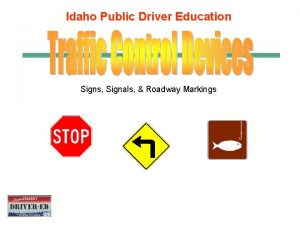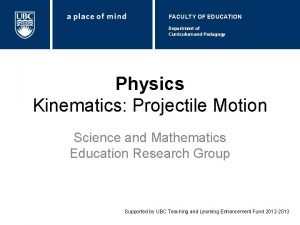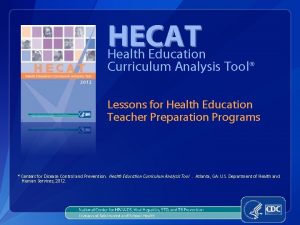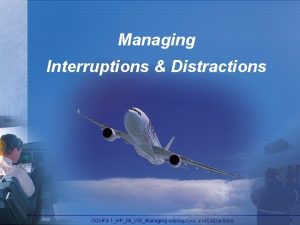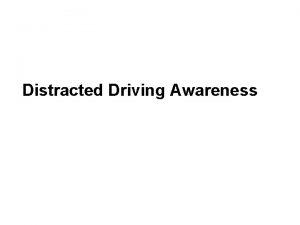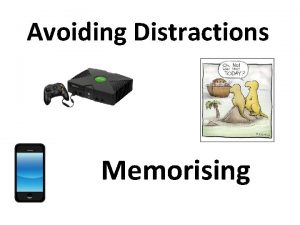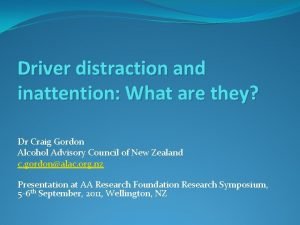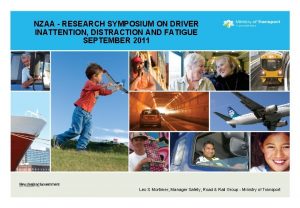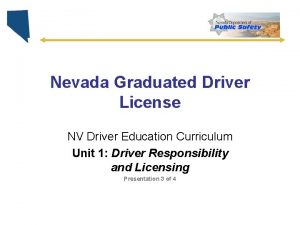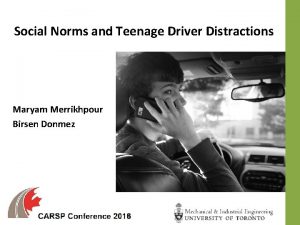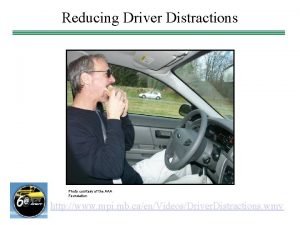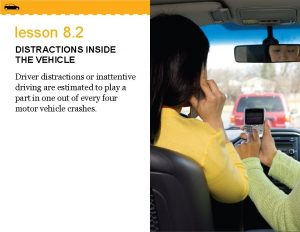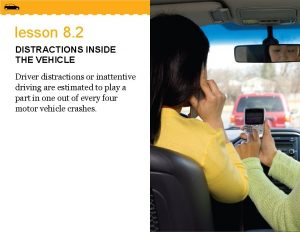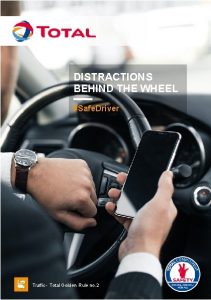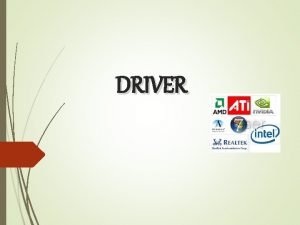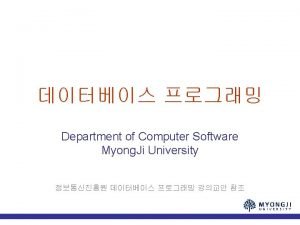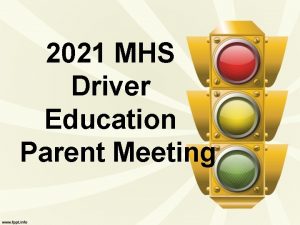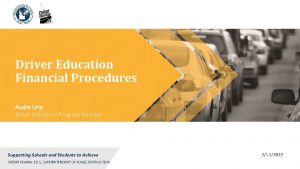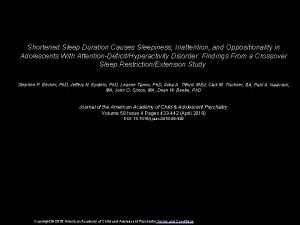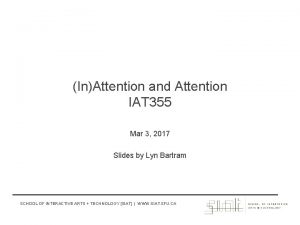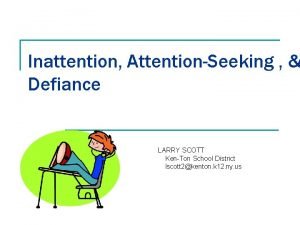Driver Inattention and Distractions NV Driver Education Curriculum
































- Slides: 32

Driver Inattention and Distractions NV Driver Education Curriculum Unit 8: Personal Factors Influencing Operator Performance Presentation 5 of 5

Before we begin. . . Let’s Talk About It Take 60 seconds to discuss: What types of distractions pull a drivers attention away from the road? Have you been in a vehicle with a distracted driver? What happened? Share thoug your hts w ith a par tner.

Inattention Causes Accidents In 2007 the National Highway Traffic Safety Administration study found that 80 percent of accidents involve some form of driver inattention within three seconds of the accident.

Distracted Driver Videos 60 Second Driver Distractions All State Insurance Craziest Driving Distractions http: //www. mpi. mb. ca/English/ dr_tips/Driver. Distractions. html http: //www. youtube. com/watch ? v=Cs 7 Gpr. Bi. Er. I (0: 60) (2: 24) Defensive Driving. com How to Avoid Distracted Driving http: //www. youtube. com/user/d efensivedriving 1#p/u/6/V 2 h 0 jx Cb. Kso (2: 11) Click on web address to access video clips *Suggest full screen viewing NOTE: Some on - Check access

Driving Demands Attention Driving is a complex task requiring focus on the driving task at all times. • Demands 100% of your attention at all times • Distractions raises your risk of being in an accident

The Driving Task Operating a vehicle requires coordination of skills: • Eye, hand, and foot coordination • Continuous eye search patterns • Repetitive actions • Procedural tasks

Driver Inattention Driver inattention is when awareness and focus drift to anything other than the driving task. • Fatigue or sleepiness • Daydreaming • Driving familiar roads • Doing non-driving tasks

Divided Attention The driving task is a mental process that requires constant attention: • Speed adjustments • Position adjustments • Communication of intentions Inattentive drivers are forced to make sudden decisions which can easily cause a collision.

Understanding Divided Attention Image juggling 3 balls and someone suddenly threw you a fourth ball. If a driver gets distracted they could: • Panic (overwhelmed with fear) • Shut down processing skills (unable to act) • React abruptly (accelerate, brake, swerve)

Attention Status of Drivers in Crashes Research shows that driver inattentiveness is a major cause of vehicle crashes. Consider what might happen if a drink spills while driving.

Distracted Driving There are three main types distraction: Visual Manual Cognitive Take your eyes off the road Take your hands off the wheel Take your mind off what your are doing

Driver Distraction Distracted driving is any non-driving activity a person engages in that takes attention away from the task of driving. • • Using a cell phone Eating and drinking Talking to passengers Grooming Changing music Reading, including maps Watching a video or navigation system

Inattention & Collisions An estimated 80% of collisions involve some form of driver inattention.

Distractions • Drivers under the age of 20 are more likely than other drivers to be identified as distracted as the time of their crash • Distractions and inattentiveness cause 68% of rear-end crashes

International PSAs TAC Victoria (Australia) Don’t Drive Distracted Hertfordshire, England Types of Distracted Drivers US - Maryland Choose Safety for Life http: //www. youtube. com/watch ? v=7 OUt. GSRIt. Uc http: //www. youtube. com/watch ? v=Fbw 2 Bri. Bnfc http: //www. youtube. com/watch ? v=w 7 Ycors. N 49 U (0: 31) (1: 28) (0: 33) Click on web address to access video clips *Suggest full screen viewing NOTE: Some on - Check access

Eyes off the Road When a driver looks away from the roadway for two or more seconds, the risk of a collision DOUBLES. Keep your eyes on your intended path of travel.

3 – 2 – 1 Seconds Every time you take your eyes off the road you put your life and others at risk. A vehicle traveling 60 mph covers: 88 feet per second (semi-truck with 2 trailers) 176 feet in two seconds (12 car lengths) 264 feet in three seconds (football field) Each length of distraction equates to “blind driving”

Distractions Inside the Vehicle • Auditory Distractions – Cell phones, music, video – Passengers talking, laughing, crying • Vehicle Equipment or Controls • Other – – Animals and insects Food and drink Grooming Loose objects

Texting is the most dangerous distraction because it involves all three types of distraction: • Visual taking you eyes off the road • Manual taking your hands off the wheel • Cognitive taking your mind off what you are doing

Teens & Texting In a 2009 survey: • One in four (26%) of American teens of driving age say they have texted while driving. • Half (48%) of all teens ages 12 to 17 say they’ve been a passenger while a driver has texted behind the wheel.

Texting and Driving Video Wales PSA Texting While Driving http: //www. youtube. com/watch ? v=R 0 LCm. St. Iw 9 E (4: 16) WARNING : Graphic Accident Portrayal – Used by Wales police in local area schools Click on web address to access video clips *Suggest full screen viewing NOTE: On - Check access

Distractions Outside the Vehicle Distractions can be caused by objects, people, and events outside the vehicle: • Crash scenes • Emergency vehicles • People and animals • Other roadway users • Eyes off the road • Billboards and road debris • Other vehicles and pedestrians

Gawking & Rubbernecking Gawking and rubbernecking are related with crash scenes and cause: • traffic backlog • rear-end collisions Gawking is often the cause of the traffic backlog, NOT the actual crash.

Reducing Distraction Reduce distraction risk: • Know vehicle equipment and controls • Set passenger expectations • Turn off technology (i. e. phones and computers) • Keep eyes on the road (use I. P. D. E. ) • Avoid driving when tired or angry • Don’t “gawk” or slow down to look at accidents or other outside distractions • Stay focused on the road

Distracted and the Law Every state has legislation under which drivers can be charged for inattentive driving. Nevada law requires drivers to use “due care” per NRS 484. 363 and those who are distracted will be cited for not using due care.

High Risk Driving High risk drivers tend to drive with: • No hands on the steering wheel • Eyes directed inside the vehicle, rather than outside • Inattention - vehicle wanders in the travel lane, or crosses into another lane

Multi-Tasking When you drive, you are already multi-tasking: • Seeing • Thinking • Responding The 4 steps of IPDE Identify Predict Decide Execute Do not make it more difficult by performing additional tasks while behind the wheel.

Safe Driving Habits Video California DMV Sharing the Road Video Safe Driving Habits Make a Difference http: //apps. dmv. ca. gov/video/le ts_drive/sharing/safe_driving_h abits/safe_driving. htm#top. Vide o (1: 45) Click on web address to access video clips *Suggest full screen viewing

Did You Know Final Thou ghts “Rubbernecking” was coined in the early 20 th century, as tourist riding in special sight seeing carriages in New York city would crane their heads to take in the views.

Test Your Knowledge You should usually slow your vehicle down when: A. You see brake lights coming on several vehicles ahead of you B. Passing large trucks on the freeway C. You want to look at an accident scene D. You are sight-seeing on a major highway

Test Your Knowledge Some things to watch for on the side of the road are: A. Pedestrians and animals B. Approaching traffic C. Road signs D. All of the above

Test Your Knowledge This warning sign means: A. Intersection warning ahead B. Two lane traffic ahead C. Right lane ends ahead D. Left lane ends ahead
 Biomechanical distraction examples
Biomechanical distraction examples An example of a biomechanical distraction is
An example of a biomechanical distraction is Inattention blindness
Inattention blindness Module 10 topic 4 drivers ed
Module 10 topic 4 drivers ed Module 7 topic 1 distracted driving
Module 7 topic 1 distracted driving Curriculum guide for driver education in virginia module 11
Curriculum guide for driver education in virginia module 11 Module 8 topic 1
Module 8 topic 1 Module 3 topic 4 basic maneuvering steering and braking
Module 3 topic 4 basic maneuvering steering and braking Curriculum guide for driver education in virginia module 3
Curriculum guide for driver education in virginia module 3 Curriculum guide for driver education in virginia module 5
Curriculum guide for driver education in virginia module 5 Module 8 topic 1
Module 8 topic 1 Chapter 8 managing distractions answers
Chapter 8 managing distractions answers Factual distractions
Factual distractions Factual distractions
Factual distractions Orderly visual search pattern definition
Orderly visual search pattern definition User-mode driver framework
User-mode driver framework Victorian curriculum health and physical education
Victorian curriculum health and physical education Victorian curriculum physical education
Victorian curriculum physical education Montana graduated drivers license
Montana graduated drivers license Signs drivers ed
Signs drivers ed No passing zone
No passing zone Example of curriculum in school
Example of curriculum in school The gifted philippines
The gifted philippines Gde strategic goals
Gde strategic goals Aim of secondary education commission
Aim of secondary education commission Outcome-based assessment in ecd
Outcome-based assessment in ecd What is curriculum in education
What is curriculum in education What is curriculum in education
What is curriculum in education What is curriculum in education
What is curriculum in education National core curriculum for basic education
National core curriculum for basic education Hidden curriculum
Hidden curriculum Hidden curriculum in education
Hidden curriculum in education Health education curriculum analysis tool
Health education curriculum analysis tool
